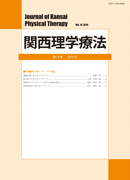Volume 15
Displaying 1-24 of 24 articles from this issue
- |<
- <
- 1
- >
- >|
Main Theme
Considering the Basic Movements
-
2015Volume 15 Pages 1-2
Published: 2015
Released on J-STAGE: January 06, 2016
Download PDF (242K) -
2015Volume 15 Pages 3-6
Published: 2015
Released on J-STAGE: January 06, 2016
Download PDF (941K) -
2015Volume 15 Pages 7-11
Published: 2015
Released on J-STAGE: January 06, 2016
Download PDF (956K) -
2015Volume 15 Pages 13-16
Published: 2015
Released on J-STAGE: January 06, 2016
Download PDF (644K) -
2015Volume 15 Pages 17-21
Published: 2015
Released on J-STAGE: January 06, 2016
Download PDF (1039K) -
2015Volume 15 Pages 23-27
Published: 2015
Released on J-STAGE: January 06, 2016
Download PDF (1442K) -
2015Volume 15 Pages 29-32
Published: 2015
Released on J-STAGE: January 06, 2016
Download PDF (831K)
Original Articles
-
2015Volume 15 Pages 33-37
Published: 2015
Released on J-STAGE: January 06, 2016
Download PDF (457K) -
2015Volume 15 Pages 39-44
Published: 2015
Released on J-STAGE: January 06, 2016
Download PDF (1010K) -
2015Volume 15 Pages 45-48
Published: 2015
Released on J-STAGE: January 06, 2016
Download PDF (533K) -
2015Volume 15 Pages 49-52
Published: 2015
Released on J-STAGE: January 06, 2016
Download PDF (751K) -
2015Volume 15 Pages 53-56
Published: 2015
Released on J-STAGE: January 06, 2016
Download PDF (480K) -
2015Volume 15 Pages 57-60
Published: 2015
Released on J-STAGE: January 06, 2016
Download PDF (590K) -
2015Volume 15 Pages 61-65
Published: 2015
Released on J-STAGE: January 06, 2016
Download PDF (898K) -
2015Volume 15 Pages 67-74
Published: 2015
Released on J-STAGE: January 06, 2016
Download PDF (1062K) -
2015Volume 15 Pages 75-78
Published: 2015
Released on J-STAGE: January 06, 2016
Download PDF (366K) -
2015Volume 15 Pages 79-84
Published: 2015
Released on J-STAGE: January 06, 2016
Download PDF (877K)
Grant-in-Aid Article
-
2015Volume 15 Pages 85-91
Published: 2015
Released on J-STAGE: January 06, 2016
Download PDF (492K)
Case Reports
-
2015Volume 15 Pages 93-99
Published: 2015
Released on J-STAGE: January 06, 2016
Download PDF (1390K) -
2015Volume 15 Pages 101-106
Published: 2015
Released on J-STAGE: January 06, 2016
Download PDF (1080K) -
2015Volume 15 Pages 107-115
Published: 2015
Released on J-STAGE: January 06, 2016
Download PDF (2064K) -
2015Volume 15 Pages 117-125
Published: 2015
Released on J-STAGE: January 06, 2016
Download PDF (2638K) -
2015Volume 15 Pages 127-134
Published: 2015
Released on J-STAGE: January 06, 2016
Download PDF (1927K) -
2015Volume 15 Pages 135-141
Published: 2015
Released on J-STAGE: January 06, 2016
Download PDF (1227K)
- |<
- <
- 1
- >
- >|
